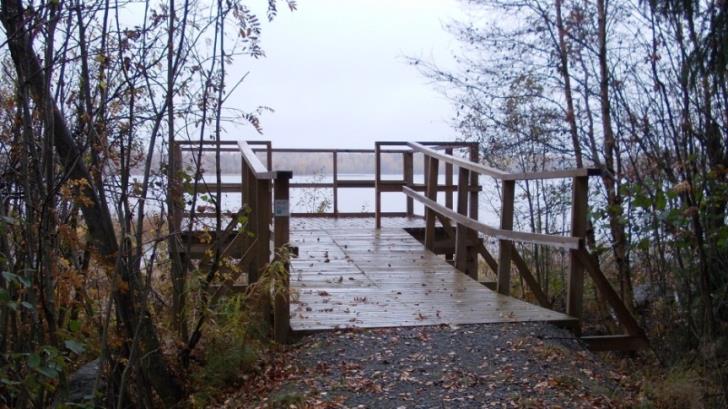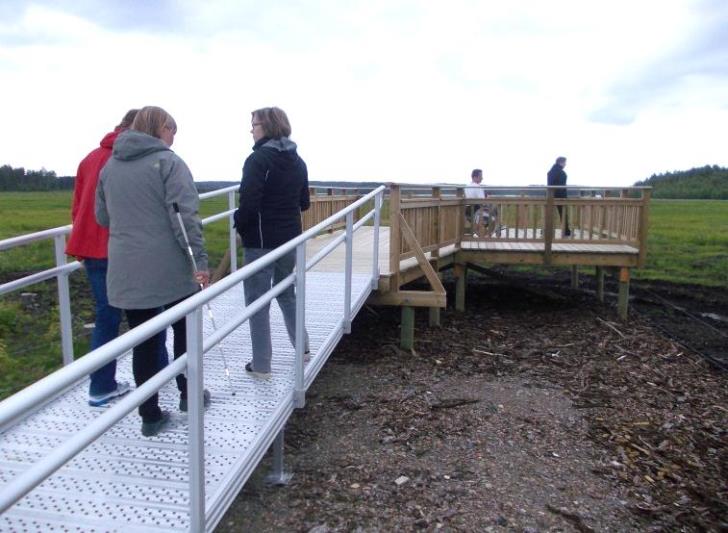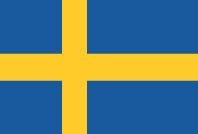Birdwatching
Skellefteå municipality's long coastal strip with varying natural environments contributes to a rich bird life with more than 200 species.
More than 200 of Sweden's 450 bird species regularly visit Skellefteå municipality. Of these, about 150 species have nesting sites in the municipality.
Tips on birdwatching sites
There are many popular bird watching sites in Skellefteå municipality.
Here are some examples of sites with varied and interesting bird life:
The joy of bird watching can come from the realization of the dream of watching an individual of a particular species in its proper environment. It can also come from seeing thousands and thousands of birds of different species in purposeful flight in one morning. At Bjuröklubb, it is the latter.
The Bjuröklubb peninsula is the easternmost part of the mainland of Västerbotten, and birds on their way to breeding grounds in the north and west pass through here in much greater numbers than in more westerly coastal areas.
Bjuröklubb
The northern tip of the peninsula, also known as Bjuröklubb, consists of a barely 50 meter high mountain from which the sea view reaches almost a 360° angle. From mid-April to mid-May, tens of thousands of passerines pass through here. At most, about 45,000 birds in a morning, with a majority of nesting and rock finches. Lots of thrushes, siskins, crossbills, field sparrows, ring doves and larks are also seen. Virtually all Swedish species of birds of prey have also been observed here.
Ground squirrel
The southern tip of the peninsula, Grundskatan, is visited in May to see seabirds. The location and shape of Grundskatan means that birds migrating along the coastline come closer to land here than is usually the case. The site is best known for the large number of passing loons. On May 28, 1987, about 6,000 migrating common loons were recorded, which is a record in Sweden. You can also see blackbirds, scoters, eiders, long-tailed ducks and cormorants throughout May.
During September to October, both Bjuröklubb and Grundskatan offer good opportunities to see south-moving birds such as ducks, gulls and waders. Most birds are normally seen when there is a north-easterly wind. The birds then take advantage of the tailwind to the south while being pushed closer to the coast.
Route description
Coming from the north on road E4: Follow signs to Bjuröklubb from Önnesmark, just before the uphill slope on Hökmarksberget. Coming from the south on road E4: Follow signs to Bjuröklubb from about 1 km north of the entrance to Lövånger.
Bjuröklubb: Follow the signed road and park in the parking lot near the end of the road (avoid parking further ahead at the lighthouse keeper's house). Continue on foot a few hundred meters along the gravel road and finally follow the path to the lighthouse.
Grundskatan: Turn right towards Grundskatan (signposted) a few kilometers before Bjuröklubb. Keep left at the junction after about 1.5 km and continue for another 1 km. Signed parking. Continue a few hundred meters out on the headland on foot. The road to Grundskatan is not always passable before May 10 due to snow.
Since the Ice Age, land uplift has shifted the boundary between sea and freshwater to the east. 500 years ago, Gärdefjärden was a bay. Today it is a bird lake where more than 140 different bird species have been recorded.
Bird species
In mid-April, the first geese roost in the fields around the village of Gärde to provide themselves with waste seeds and plant parts for their continued journey north. Bean geese and gray geese are best seen from the road south and north of Gärde. Even cranes in large numbers can be seen from here. Rarities such as brown duck and lesser spotted woodpecker are occasionally seen in the reserve.
Viewpoints
The first ice-free surface in the lake thaws in mid-April at the bridge over the water between Åviken and Gärdefjärden. This place, together with the bay northwest of the bridge, is best viewed from the road next to the bridge. In the ice-free parts and eventually in the entire lake, hundreds of swimming and diving ducks and whooper swans rest until May 15-20. The central and southern parts of the lake are best seen from Skolberget just north of Lövånger. Near the old soldier's cottage there is a path that leads to a platform overlooking the bay.
In mid-May you can often see flocks of hundreds of whooping cranes and golden plovers in the fields near the E4 highway.
Nature reserve
Gärdefjärden is a shallow lake with lush underwater vegetation. Especially in the northwestern part, there are good conditions for leafy reeds, rushes and sedge meadows to spread. During the summer, large parts of the water surface are also covered by floating-leaf plants. In this area, mountain cows graze in summer and play an important role in the management of the reserve. The area has been a nature reserve since 1972.
From June onwards, it is mainly the breeding species that can be found in the area. A total of 57 different species have been observed as breeding birds. Among these, ducks, gulls and waders are often seen. In addition, osprey and brown harrier often visit the lake.
Directions
Farmland north and south of Gärde.
Bridge over the water between Åviken and Gärdefjärden.
Skolberget. Turn off the E4 towards Lövånger. Take the first road to the left after the bus station. Pass the sports field and park at the edge of the forest in the northwest corner of the residential area. Continue 50 m on foot up the hill.
The lower part of the Skellefteälven river is an area close to the city that is the best place in the Skellefteå area to see the earliest migratory birds as well as resting ducks and waders.
Bird species
Before the Skellefteälven river reaches the sea, it widens and distributes its water in a delta-like area that includes Ursvikenfjärden, Nordfjärden and Ytter- and Innerviksfjärden. The area has shallow beaches and sandbars that offer ducks and waders a much-needed break in their continued migration north and west. The duck flocks are dominated by mallard and teal and the waders by dunlin and dunlin. The slender grey-headed grebe is common and brown harrier and osprey are regularly seen in the area. The best conditions for seeing waders are at low tide.
Viewpoints
Birds in Ursvikenfjärden are best seen from the road leading out to Björnsholmen or from the shore of Skellefteälven at Ursviken's mechanics. Nordfjärden is best viewed from the road between Stackgrönnan and Örviken. From Öberget you get the best view of Norra Innerviksfjärden. There is also a shelter with a barbecue area for protection in bad weather and sun-warmed rocks to sit on in good weather.
As the first patches of bare ground thaw through the snow cover, the first birds arrive in the meadows around Innervik. In mid-April, skylarks, snow buntings, starlings, lapwings, curlews and ring doves arrive. Birds of prey such as buzzards, kestrels, stone falcons and blue harriers arrive shortly afterwards. Innerviksängarna is best viewed from Innervik about 5 km south of Skellefteå.
The entire area is largely covered by the 1,500 hectare Innerviksfjärden nature reserve. About 190 different bird species have been noted in the area. Of these, about 80 species are breeding birds.
Route description
Road to Björnsholmen: Follow the road from Skellefteå along the southern bank of Skellefteälven through Södra Bergsbyn, Stackgrönnan and Nyhamn. Continue the road straight ahead after Nyhamn for another 600 m.
Skellefteälven's shore at Ursviken's mechanics: Follow road 372 from Skellefteå to Skelleftehamn. Turn right in Ursviken opposite OK and follow the road east to the industrial area.
Road between Stackgrönnan and Örviken. Follow the road from Skellefteå along the southern bank of Skellefteälven through Södra Bergsbyn. Turn right towards Örviken when you reach Stackgrönnan. Follow the road for about 3.5 km.
Öberget: Follow the road from Skellefteå along the southern shore of Skellefteälven through Södra Bergsbyn. Turn right towards Örviken when you reach Stackgrönnan. Follow the road for about 1.5 km. Öberget is reached via a signposted walking path up from Örvikenvägen.
Innerviksängarna: Take the E4 south from Skellefteå. Take the old E4 towards Tjärn and Innervik on the outskirts of the city. Continue the road south for about 5 km and turn left at the second road towards Innervik. The meadows can be found along the road towards Innervik.
The shallow and vegetation-rich parts of Skellefteälven with its lush deciduous forest-dominated banks on the stretch between Parkbron and Lejonströmsbron offer a rich and varied bird life just a stone's throw from the city center. The area is interesting for many different species as a resting place during spring and fall or as a breeding ground throughout the summer.
A bird paradise
At the end of March, the first woodcocks appear in the ice-free stream that is always present on the south side of the river below the Sunnanå cemetery. Every day there are more goldeneyes and even mallards begin to arrive in greater numbers. At this time, a few Common Terns are often seen sitting on the ice edge between their dives for insect larvae in the cold water. In the coastal forests, the first chaffinches can be heard singing. For the observant visitor, early April is a good time to hear the soft, rapid ki-ki-ki-ki-ki-ki of the lesser spotted woodpecker from one of the leafy islands in the river. The lesser spotted woodpecker is an endangered species that requires plenty of dead and dying deciduous trees for its survival. Along the river there is still some old deciduous forest in the area that provides space for a few breeding pairs.
A few weeks into April, the river begins to open up more and more and the area now becomes an eldorado for resting ducks with the mallard as the most common guest. Other common species are teal, mallard, wigeon, curlew and Canada goose. Fewer, but still annually resting, are Pintail, Common Merganser and Whooper Swan. With a bit of luck, you can also see black-necked grebe and coot.
At this time in April and early May, the promenade on the north side of the river, between the waterworks and Kyrkholmen, usually offers the best observation points.
Birds singing in chorus
During May, the number of resting ducks rapidly decreases and the local breeding birds remain, including the gray-headed grebe, which nests with a few pairs. From May and well into the summer, the lush areas of deciduous forest are particularly interesting and offer rich opportunities to hear birdsong from a variety of species. In addition to the chorus of warblers, garden warblers, black and white flycatchers, chiffchaffs and red-winged blackbirds, you can hear green warbler, blackcap and rosefinch. The area is also home to the stonechat, a southern species that thrives in lush deciduous forests. The stonechat is a hidden gem and often difficult to spot, but it announces its presence with its harsh metallic ticking sound.
The best area to hear birdsong is along the promenade on the north side of the river, from Nordanå and up towards the country church and around Rovön.
Canada geese
During the fall, the area is an important resting place for Canada geese and up to 500 individuals can be seen at the same time spending the night on the river. Among all the Canada geese there are often a few barnacle geese and sometimes a gray goose.
Whether you take regular walks or stroll along the river once a year, the birdlife can provide an extra experience. For those who often return to the area, the chance is given to gradually learn more about the appearance and sounds of different species and actually get a pretty good picture of "bird life all year round" in Skellefteå.
Directions to the site
For visitors who come by car to the area, parking is recommended at Nordanå, Bonnstan or Rovön.
In spring, the Ostträskets nature reserve is one of the best places in Norrland to see resting geese. When the first patches of bare ground appear in the snow, the first geese usually arrive.
From mid-April and a month onwards, Brent geese, gray geese and Canada geese gather here in their hundreds. Together with the resting cranes and whooper swans, the number of birds sometimes reaches more than a thousand individuals, who at the same time take a break from their migration to the breeding grounds to the north and west.
The bird habitat consists of the lake Ostträsket, which is a shallow lake with large ridges of reeds and seaweed. The lake is surrounded by lush wetlands, swamp forests and marsh meadows and, to the west, extensive arable land. These fields also form a significant part of the bird habitat.
Bird species
The lake is best viewed from the bird tower on the southern shore. This provides a good view of the western part of the lake in particular. A number of seabirds such as blue duck, teal, lapwing, lapwing and shrike rest in the lake.
The fields west of Ostträsket are best viewed from Tällåsen. From here you can follow the movement of the goose flocks in the morning and evening between the night quarters on the sea ice and grazing in the meadows. Birds of prey such as Västerbotten's landscape bird curlew, blue harrier, buzzards, kestrel, stone falcon, sea eagle, golden eagle and peregrine falcon are also best seen from Tällåsen.
During the summer, it is mainly the species that breed in the area that can be seen. These include the bearded grebe, black-throated diver, gray-throated diver, several other seabird species and a large number of waders. In addition, ospreys are often seen striking their prey in Ostträsket.
Birds also rest in the area in the fall, albeit in much lower numbers. From mid-August to mid-September, a large number of cranes usually stay near the lake.
Access during the prohibition period
Visitors are welcome to use the roads, marked paths and the bird tower even during the closed season. There is a ban on access to the reserve during the period April 15 - May 31. To Ostträskets nature reserve, it is the birds that have priority, which also makes it one of Norrland's best places for resting geese.
Route description
About 1 km east of Drängsmark, take the road north towards Stormark. Turn right in the direction of Tällåsen after about 1 km. Follow the 2 km long road to the parking lot. There is a 1 km long path to the bird tower.
If you want to visit Tällåsen, park where the road makes a sharp right turn about 1 km before the parking lot for the bird tower. Then continue on foot north for a short distance along a road.
Bird watching for everyone
In Skellefteå municipality there are special places for birdwatching that are adapted for accessibility.

Vid Danielsten, havsbadet i Bureå, kan man göra mer än att bada. Här finns nämligen en plattform för fågelskådning som är anpassad för rullstol.
Utsikten från plattformen är in mot havsviken i Burefjärden. Här finns möjlighet för den som besöker att få se många olika fågelarter, exempelvis fiskgjuse eller videsparv. Men det händer även att platsen besöks av mer ovanliga fåglar för oss här i norra Sverige.
Så packa ryggsäcken med något gott att fika och ha kikaren redo!
Här finns:
- En vattentoalett anpassad för rullstol.
Bra att veta:
- Plattformen har ramp och räcken på tre sidor.

Vid Ostviks strandängar finns ett trevligt utflyktsmål för den som vill ägna såg åt fågelskådning. Här hittar du nämligen en plattform för fågelskådning anpassad för rullstol.
Fågelplattformen är stor och rymmer många människor samtidigt. Utsikten från plattformen är över de vidsträckta strandängarna som röjdes upp i ett stort projekt några år sedan. Strandängarna erbjuder även betesmarker för boskap från närliggande lantbruk.
Den som besöker platsen kan få se vanliga fågelarter som trana och tofsvipa, men det händer även att ovanligare arter stannar till för ett besök.
Här finns:
- Parkering finns i anslutning till fågelplattformen.
Bra att veta:
- Det finns ingen toalett i området.
Birding in spring
Early spring mornings are the best time to experience the rich bird life and get the chance to see thousands of birds at the same time. Curlews, lapwings and cranes, for example, are a sure sign of spring.
- In Bjuröklubb, you can see tens of thousands of migrating passerines, such as chaffinches and chaffinches, as well as most of Sweden's raptor species between April and May.
- In Ostträskets Nature Reserve you can see thousands of geese, cranes and whooper swans in April-May. Here you can also experience the colorful rooster's fight for the females' favor in May.
- From Grundskatan you can experience migrating seabirds during May.
- In Ursvikenfjärden you can see lots of seabirds and waders in May. In the old-growth forest you can see spectacular games such as black grouse on marshes and capercaillie in the spring.
Bird watching in summer
In late spring and early summer you can see, hear and experience nesting birds.
The gray-crowned cuckoo with its piercing call is a species that has a strong foothold in Skellefteå municipality. Another example is the short-eared owl, which you can see chasing voles across the meadowland on summer evenings, and the great skua, which you can hear in the evening.
Bird watching in the fall and winter
From mid-August to early October, many birds move south to spend the winter in warmer climates. Nevertheless, you can still see, hear and experience an interesting bird life in the fall in Bjuröklubb and Grundskatan in the form of ducks, waders and gulls.
In winter, around 50 species remain in Skellefteå municipality.

